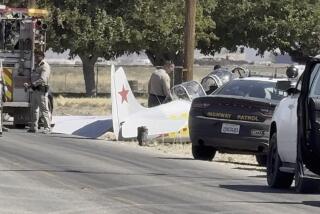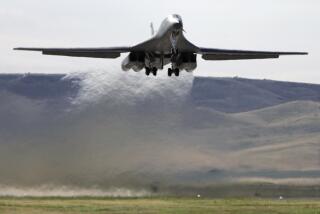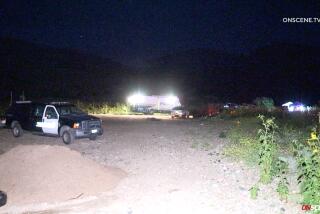4 Believed Dead in Crash of B-1 Bomber : Military: Accident in Texas was fourth crash involving the aircraft. Unconfirmed reports say one crewman survived.
WASHINGTON — An Air Force B-1 bomber crashed into a hillside in western Texas late Monday, bringing to four the number of B-1s destroyed in accidents.
All four crewmen were feared dead in the crash, which occurred about 10 p.m. PST Monday. But there were late reports Tuesday, not confirmed by the Air Force, that one crew member survived. The bomber was one of several dozen based at Dyess Air Force Base in Texas.
The B-1 accident followed by hours a Monday night collision above Montana of two Air Force C-141 transport jets. All 13 crew members aboard the two aircraft were believed dead.
The planes had just completed an airborne refueling maneuver and were flying in a formation of four aircraft at the time of the collision. The refueling was conducted in clear weather. While it is a delicate operation, officials describe the link-up as “normal and routine.”
By day’s end, the remains of 12 crew members had been recovered, according to Sgt. Karla Shadrick, a spokeswoman at Malmstrom Air Force Base, where the C-141s were based. The wreckage of the two cargo planes was strewn over 21 square miles of the north-central Montana prairie, about 30 miles south of the Canadian border.
The B-1 bomber, which was designed to deliver nuclear bombs but now is being given an expanded role in conventional warfare, was on a routine training mission and was unarmed at the time it went down in the Sierra Vieja mountains about 150 miles southeast of El Paso.
“It evidently smashed into the side of a cliff,” said 2nd Lt. Micah Morgan, an Air Force spokesman on the scene. “There were pieces of the aircraft all over.”
He said that the wreckage was in a canyon and reachable only by helicopter.
The crash is the latest chapter in the troubled history of an aircraft that was canceled by the Jimmy Carter Administration, then revived and built under former President Ronald Reagan. The four-engine, swing-wing bomber has been grounded several times and was not used in the Persian Gulf War because of technical problems.
Besides the four planes destroyed in crashes since the craft was first deployed eight years ago, a prototype was demolished in a test flight.
Air Force Maj. Bob Perry, a spokesman for the service’s Air Combat Command, said that there has been no decision to ground B-1s as a result of the crash. The bomber, manufactured by Rockwell International Corp., is equipped with sensors that permit it to skim along the contours of the Earth on auto pilot, at altitudes of less than 500 feet. Those sensors consistently have failed to meet Air Force requirements.
The cause of the crash was not clear Tuesday.
The Air Force has 100 B-1 bombers, built at a total cost of $28 billion. The plane’s crash rate of 2.83 crashes per 100,000 hours of flight is among the service’s worst and its accident rate is more than five times higher than that of the B-52, the aircraft the B-1 was built to replace.
The fleet was grounded earlier this year after a bomber experienced engine trouble. Three months earlier, some B-1s were grounded after cracks were found in the landing gear assemblies of more than half the fleet. The Air Force has said that it would cost $2.5 billion to fix flaws in the plane and equip it to conduct conventional warfare missions in the post-Cold War era.
B-1B Strategic Bomber
Type: Long-range multi-role strategic bomber
Length: 147 ft.
Wingspan: 136 ft. 8 1/2 in. fully spread. 78 ft. 2 1/2 in. fully swept.
Range: 7,455 miles
Max. speed: Mach 1.25
First flown: Oct. 18, 1984
Source: Jane’s All the World’s Aircraft 1987-88
More to Read
Sign up for Essential California
The most important California stories and recommendations in your inbox every morning.
You may occasionally receive promotional content from the Los Angeles Times.










